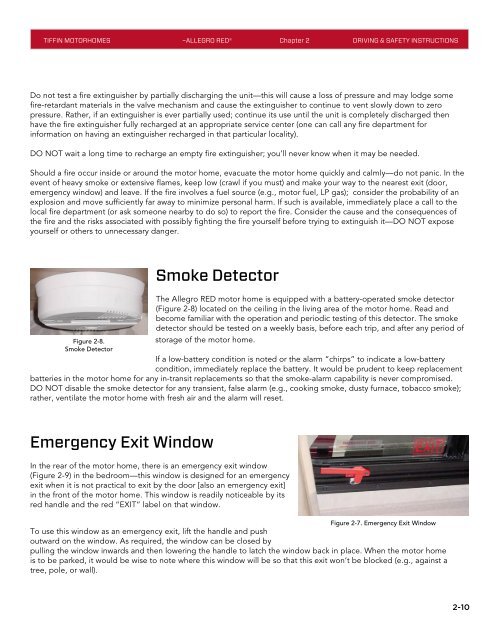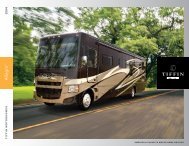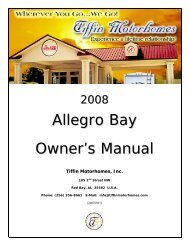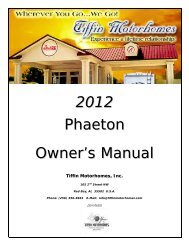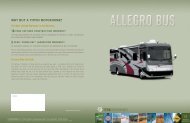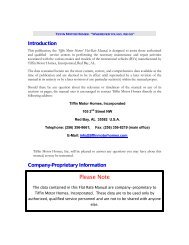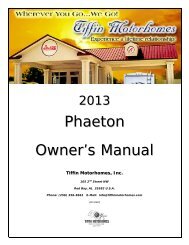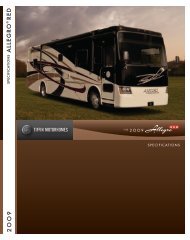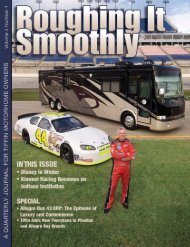Allegro RED Owner's Manual - Tiffin Motorhomes
Allegro RED Owner's Manual - Tiffin Motorhomes
Allegro RED Owner's Manual - Tiffin Motorhomes
- No tags were found...
Create successful ePaper yourself
Turn your PDF publications into a flip-book with our unique Google optimized e-Paper software.
TIFFIN MOTORHOMES –ALLEGRO <strong>RED</strong>® Chapter 2 DRIVING & SAFETY INSTRUCTIONSDo not test a fire extinguisher by partially discharging the unit—this will cause a loss of pressure and may lodge somefire-retardant materials in the valve mechanism and cause the extinguisher to continue to vent slowly down to zeropressure. Rather, if an extinguisher is ever partially used; continue its use until the unit is completely discharged thenhave the fire extinguisher fully recharged at an appropriate service center (one can call any fire department forinformation on having an extinguisher recharged in that particular locality).DO NOT wait a long time to recharge an empty fire extinguisher; you’ll never know when it may be needed.Should a fire occur inside or around the motor home, evacuate the motor home quickly and calmly—do not panic. In theevent of heavy smoke or extensive flames, keep low (crawl if you must) and make your way to the nearest exit (door,emergency window) and leave. If the fire involves a fuel source (e.g., motor fuel, LP gas); consider the probability of anexplosion and move sufficiently far away to minimize personal harm. If such is available, immediately place a call to thelocal fire department (or ask someone nearby to do so) to report the fire. Consider the cause and the consequences ofthe fire and the risks associated with possibly fighting the fire yourself before trying to extinguish it—DO NOT exposeyourself or others to unnecessary danger.Smoke DetectorThe <strong>Allegro</strong> <strong>RED</strong> motor home is equipped with a battery-operated smoke detector(Figure 2-8) located on the ceiling in the living area of the motor home. Read andbecome familiar with the operation and periodic testing of this detector. The smokedetector should be tested on a weekly basis, before each trip, and after any period ofFigure 2-8.storage of the motor home.Smoke DetectorIf a low-battery condition is noted or the alarm “chirps” to indicate a low-batterycondition, immediately replace the battery. It would be prudent to keep replacementbatteries in the motor home for any in-transit replacements so that the smoke-alarm capability is never compromised.DO NOT disable the smoke detector for any transient, false alarm (e.g., cooking smoke, dusty furnace, tobacco smoke);rather, ventilate the motor home with fresh air and the alarm will reset.Emergency Exit WindowIn the rear of the motor home, there is an emergency exit window(Figure 2-9) in the bedroom—this window is designed for an emergencyexit when it is not practical to exit by the door [also an emergency exit]in the front of the motor home. This window is readily noticeable by itsred handle and the red “EXIT” label on that window.Figure 2-7. Emergency Exit WindowTo use this window as an emergency exit, lift the handle and pushoutward on the window. As required, the window can be closed bypulling the window inwards and then lowering the handle to latch the window back in place. When the motor homeis to be parked, it would be wise to note where this window will be so that this exit won’t be blocked (e.g., against atree, pole, or wall).2-10


